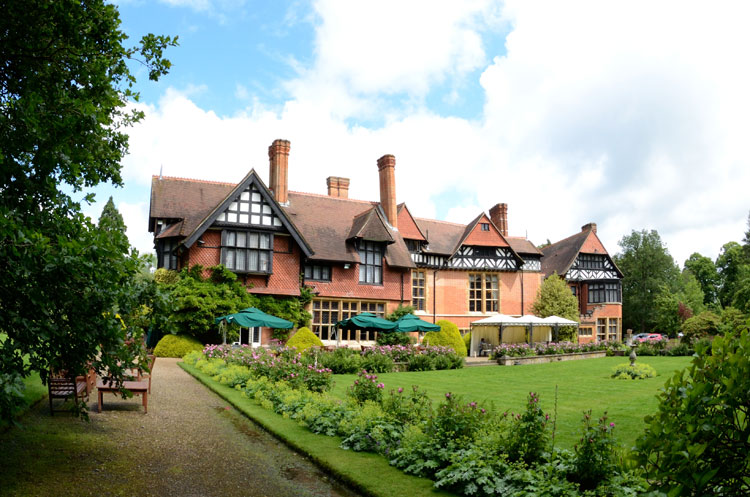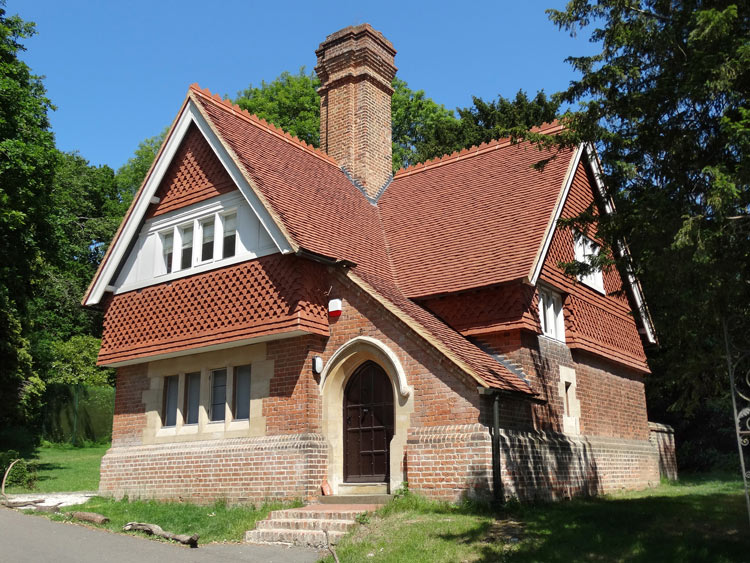|
Grim's Dyke, a Grade II listed property
and estate off Old Redding in Harrow Weald,
northwest London seen in the episode
You Can Always Find a Fall Guy is a favourite
haunt of Randall and Hopkirk fans.
In fact,
Grim's Dyke was a regularly returned-to filming location for
ITC series, with episodes of The Saint ('The
Russian Prisoner' and 'The Fiction Makers'), The
Champions ('The Mission', 'The Experiment', 'The
Body Snatchers' and 'The Final Countdown'),
Department S ('The Bones of Byrom Blain') and
The Adventurer ('The Case of the Poisoned Pawn')
being filmed there, too.
The beautiful Grim's Dyke was
originally designed by the renowned British
architect Richard Norman Shaw (1831-1912) in 1870
and built between that year and 1872 as a private
residence for the artist Frederick Goodall
(1822-1904). Grim's Dyke takes its name from
Grims Ditch, an ancient defensive earthwork and
scheduled monument which runs nearby. Thought to
have been constructed by the Catuvellauni tribe as a
defence against the Romans, Grim's Ditch extended
east-to-west for about 6 miles (9.7 km) from the edge of
Stanmore to Cuckoo Hill, north of Pinner Green. Today, the remaining earthworks start midway at
Harrow Weald Common.
Goodall retained the property
for eight years before selling to Robert Heriot in
1880. It was later purchased from Heriot in 1890 for
£4,000 by Sir William Schwenck Gilbert (1836-1911),
dramatist, librettist, poet and illustrator,
best known for his work with composer Arthur
Sullivan. Together as Gilbert and Sullivan they
created 14 comic operas between 1871 and 1896,
including The Pirates of Penzance, The
Mikado and HMS Pinafore. Gilbert was
knighted in 1907 in recognition of his services to
drama, becoming the first British writer to receive
a knighthood for theatrical work alone. His partner
Sullivan with whom he shared an often fractious
relationship had received the same award in 1883,
to mark his contributions to music.
Gilbert lived with his wife
Lucy Turner Gilbert (m. 1867) and farmed on the
Grim's Dyke estate for more than twenty years.
Tragically, on 29th May 1911, he would lose his life
in a lake in the grounds. He had been about to give
a swimming lesson in the lake to two young women,
Winifred Isabel Emery (1890-1972) and Ruby Preece
(1894-1966), when Preece got into difficulties and
called for help. Gilbert dived in to save her but
suffered a heart attack brought on by excessive
exertion in the middle of the lake and died
instantly at the age of 74. The coroner's jury
recorded a verdict of accidental death. Shortly
thereafter, Lady Gilbert had the lake closed off and
largely drained. Since that time, silt has built up
in the lake and trees and other vegetation have
grown, dividing it into smaller ponds.

|
The south elevation of Grim's Dyke Hotel
Image © Alys Hayes, 2012 |
| |
Following Lady Gilbert's death
in 1936, Grim's Dyke was purchased at public auction
by Middlesex County Council and London County
Council, the price paid being £4,600. In turn, the
councils leased the property from 1937 to 1962 to
the North West Regional Hospital Board, which used
it as a tuberculosis rehabilitation centre, although
the house was used by the services during World War
II. From 1963, the house was used primarily as a
location for films and television, including the
aforementioned ITC series, Doctor Who: The
Evil of the Daleks (1967) and Futtock's End
(1970). It was placed on the Statutory List of
Buildings of Special Architectural or Historic
Interest (Grade II) on 5th September 1969 and was then converted into a hotel in 1970,
not that this prevented further film and television
appearances. Indeed, one of its most famous
on-screen 'roles' was in Sir John Betjeman's
acclaimed television documentary Metro-Land
(1973), in which the hotel interiors were used
extensively. The Grim's Dyke Hotel was also seen in an
episode of the long-running BBC soap opera
EastEnders in 2003.
What perhaps those visiting
location hunters miss as they cut to the chase - the
main hotel building, which, it must be said, does
not disappoint - is the Gatehouse or South Lodge,
seen only in Randall and Hopkirk (Deceased): You Can Always Find a Fall Guy.
In common with the main house, the Gatehouse is also
a Grade II listed building in its own right,
constructed in the late 1800s on the southern extent
of the Grim's Dyke estate.
For all the attention afforded
to the house and its history, in 2020, it was the
Gatehouse that grabbed the headlines. By this time,
the Gatehouse had been neglected for some years, was
uninhabited, and was considered derelict. Easily
accessible from the public road outside the entrance
gates, the Gatehouse caught fire in the early hours
of Tuesday 7th April 2020, quite possibly due to
arson, though the cause has not been established for
certain.
Read the news report at Harrow Online (includes
photographs)
The Fire Brigade was called and
fire crews from Stanmore and Harrow fire stations
attended the incident. In all, four fire engines and
25 firefighters arrived to fight the fire and were
present from 5.08am. The fire was eventually brought
under control just over two hours later by 7.11am.
Mercifully, there were no reports of any injuries
caused by the fire.
The damage, however, was
extensive... The Gatehouse roof and much of the
structure, including the upper floor, were
completely destroyed. Once the fire was extinguished
and the smoke had dissipated, it was plain to see
that the building was in a very sorry state indeed.
Best Western Hotels - the
current owners of the Grim's Dyke Hotel and estate -
and Historic England collaborated to restore the
Gatehouse to its former glory. Fortunately, a
faithful reconstruction of the building was
possible, including the use of handmade clay tiles
from one of the few British producers that still
makes them to the imperial size required. The
reconstruction work
was completed in 2022 - and the results of the
rebuild are quite remarkable...
 |



